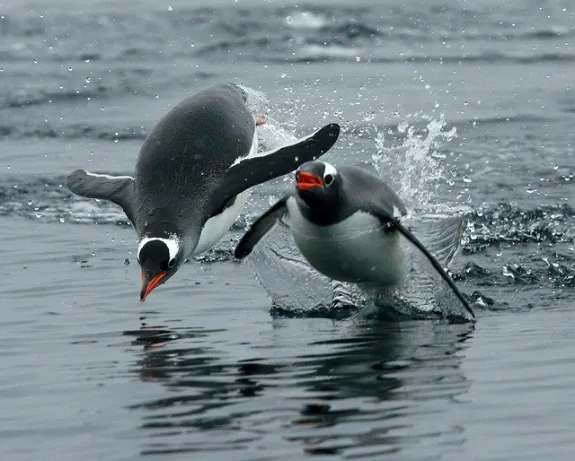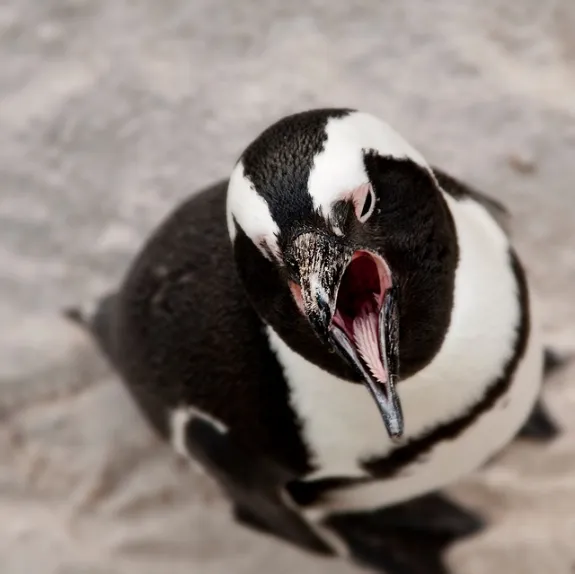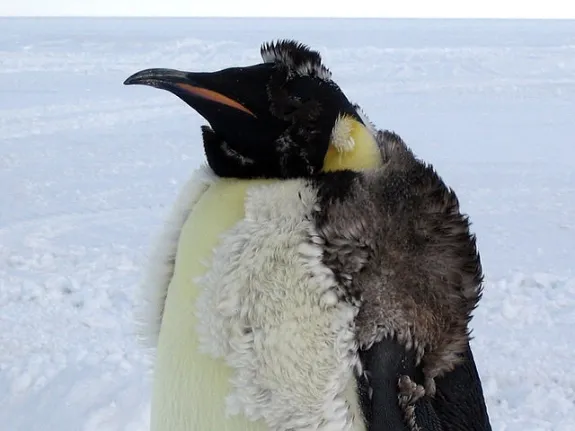14 Fun Facts About Penguins
Which penguin swims the fastest? Do penguins have teeth? Why do penguins sneeze? How is penguin poop useful?
/https://tf-cmsv2-smithsonianmag-media.s3.amazonaws.com/filer/20130425093230penguins-underwater-small.jpg)
Penguins seem a bit out of place on land, with their stand-out black jackets and clumsy waddling. But once you see their grace in the water, you know that’s where they’re meant to be–they are well-adapted to life in the ocean.
April 25 of each year is World Penguin Day, and to celebrate here are 14 facts about these charismatic seabirds.
1. Depending on which scientist you ask, there are 17–20 species of penguins alive today, all of which live in the southern half of the globe. The most northerly penguins are Galapagos penguins (Spheniscus mendiculus), which occasionally poke their heads north of the equator.
2. While they can’t fly through the air with their flippers, many penguin species take to the air when they leap from the water onto the ice. Just before taking flight, they release air bubbles from their feathers. This cuts the drag on their bodies, allowing them to double or triple their swimming speed quickly and launch into the air.
3. Most penguins swim underwater at around four to seven miles per hour (mph), but the fastest penguin—the gentoo (Pygoscelis papua)—can reach top speeds of 22 mph!

4. Penguins don’t wear tuxedos to make a fashion statement: it helps them be camouflaged while swimming. From above, their black backs blend into the dark ocean water and, from below, their white bellies match the bright surface lit by sunlight. This helps them avoid predators, such as leopard seals, and hunt for fish unseen.
5. The earliest known penguin fossil was found in 61.6 million-year old Antarctic rock, about 4-5 million years after the mass extinction that killed the dinosaurs. Waimanu manneringi stood upright and waddled like modern day penguins, but was likely more awkward in the water. Some fossil penguins were much larger than any penguin living today, reaching 4.5 feet tall!
6. Like other birds, penguins don’t have teeth. Instead, they have backward-facing fleshy spines that line the inside of their mouths. These help them guide their fishy meals down their throat.

7. Penguins are carnivores: they feed on fish, squid, crabs, krill and other seafood they catch while swimming. During the summer, an active, medium-sized penguin will eat about 2 pounds of food each day, but in the winter they’ll eat just a third of that.
8. Eating so much seafood means drinking a lot of saltwater, but penguins have a way to remove it. The supraorbital gland, located just above their eye, filters salt from their bloodstream, which is then excreted through the bill—or by sneezing! But this doesn’t mean they chug seawater to quench their thirst: penguins drink meltwater from pools and streams and eat snow for their hydration fix.
9. Another adaptive gland—the oil (also called preen) gland—produces waterproofing oil. Penguins spread this across their feathers to insulate their bodies and reduce friction when they glide through the water.
10. Once a year, penguins experience a catastrophic molt. (Yes, that’s the official term.) Most birds molt (lose feathers and regrow them) a few at a time throughout the year, but penguins lose them all at once. They can’t swim and fish without feathers, so they fatten themselves up beforehand to survive the 2–3 weeks it takes to replace them.

11. Feathers are quite important to penguins living around Antarctica during the winter. Emperor penguins (Aptenodytes forsteri) have the highest feather density of any bird, at 100 feathers per square inch. In fact, the surface feathers can get even colder than the surrounding air, helping to keep the penguin’s body stays warm.
12. All but two penguin species breed in large colonies for protection, ranging from 200 to hundreds of thousands of birds. (There’s safety in numbers!) But living in such tight living quarters leads to an abundance of penguin poop—so much that it stains the ice! The upside is that scientists can locate colonies from space just by looking for dark ice patches.
13. Climate change will likely affect different penguin species differently—but in the Antarctic, it appears that the loss of krill, a primary food source, is the main problem. In some areas with sea ice melt, krill density has decreased 80 percent since the 1970s, indirectly harming penguin populations. However, some colonies of Adelie penguins (Pygoscelis adeliae) have grown as the melting ice exposes more rocky nesting areas.
14. Of the 17 penguin species, the most endangered is New Zealand’s yellow-eyed penguin (Megadyptes antipodes): only around 4,000 birds survive in the wild today. But other species are in trouble, including the erect-crested penguin (Eudyptes sclateri) of New Zealand, which has lost approximately 70 percent of its population over the past 20 years, and the Galapagos penguin, which has lost more than 50 percent since the 1970s.
Learn more about the ocean from the Smithsonian’s Ocean Portal.